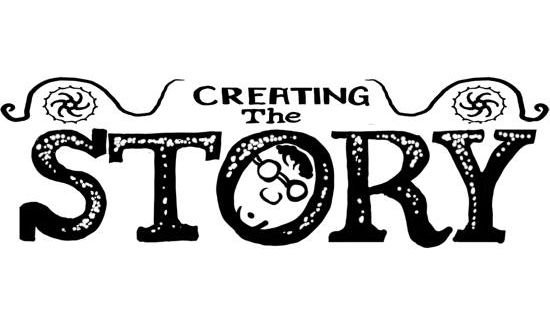



It has been a while since I wrote about how I make the comic about Phill from GCHQ. You can read the comic in its entirety (it's not finished but there are 35 pages) here:
https://phillfromgchq.co.uk
And the earlier instalments of this series can be read here:
For the readers that actually are going to read this... there is a small competition hidden in the text. 2 SBD is the prize!

Introduction
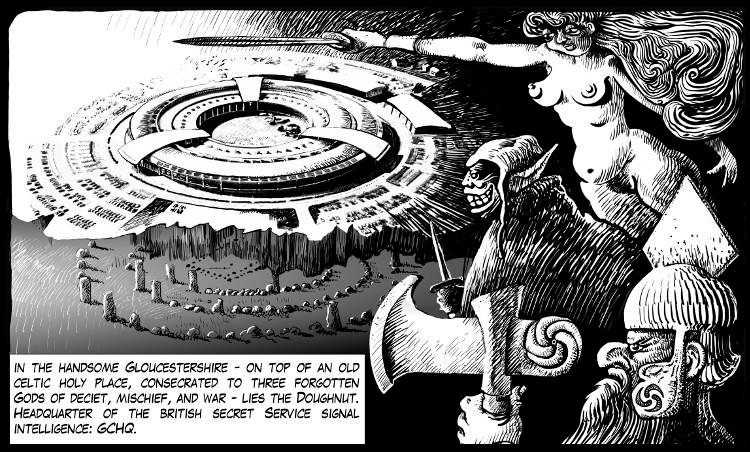
When I started making Phill from GCHQ it was solely meant as an experiment. I made three pages and then I abandoned it for another project, a dark fantasy comic of which you can see some concept art here: Concept art for dark fantasy cartoon. So as I continued these three pages it was only with a very vague sense of what was going to happen.
Normally you will advice people to have at least a finished draft of how things should unfold in the story, but there is actually great stories that aer written as serials, most famously the works of Charles Dickens. When reading one of his books in the original version you can feel that even the writer is interested in what is going to happen next. Another fine example, but maybe a bit nerdy is the very complex eighteen century novel by Laurence Sterne, The Life and Opinions of Tristram Shandy, Gentleman

Into the unknown... armed with rules
There is something liberating about the approach, and the author benefits from not having to go about the tedious drill of illustrating something that is already finished in his or her head. Sadly I have also seen that it does risk being a little bit or sometimes a very large bit boring. The author already lives in the selfcreated universe, and sometimes forget that people will have to make an effort to get there too. And webcomics are extra vulnerable to this as they are made without much expenses, and often without an editor.
So early on I decided to follow some self-imposed rules. Readers of my blog (all five of them), will not be surprised - I live by self-imposed rules.
Rule no. 1: Always end the page with a cliffhanger
This trick is as old as comics themselves. If you go to your book-shelf and pick up any album from your complete collection of Tintin - you do have the complete collection.... right? - then you will see that almost every page ends in a cliffhanger. The principle is followed through with consequence - and often there is no real danger. The voice saying: "hands up or I will shoot" is only a parrot - the strange person knocking on the door in the night is just the annoying insurance salesman, Séraphin Lampion. But it still makes you turn the page, and it makes the cartoonist struggle a bit to come up with something exiting.


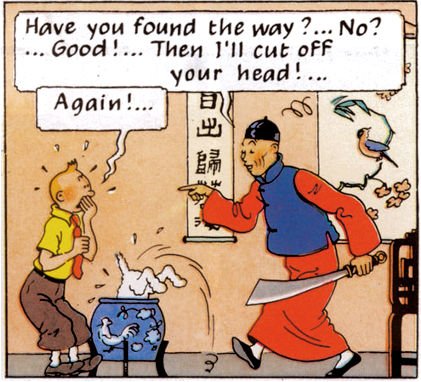
Below you can see the same simple trick used in Phill from GCHQ:



Rule no. 2: Always finish what you started
This second rule is closely related to the principle called Chekhov's gun. It states that if a thing is mentioned it should be used, and is formulated by the Russian author Anton Chekhov. The reason it is called a gun is that the maxim says: "If you put a gun in the first act, then you have to fire it in the second."
So I reuse both supporting characters and things that are mentioned as best I can. Below is one examples:
The heater was just a whim. I wanted the caretakes Eileen to be a bit harsh and commanding, and I also wanted her to be capable of repairing things and all in all be self-reliant, even on fields that are stereotypically male: like repairing machinery.

But I knew as soon as I wrote it that the heater (oil furnace) had to play a role somehow. Quite a few pages later I had the idea how to use it. Phill, the hero of the tale, phones Eileen from the woods to make her come to the house so he can get his mobile phone back (he hid it in her trunk to confuse potential enemies).
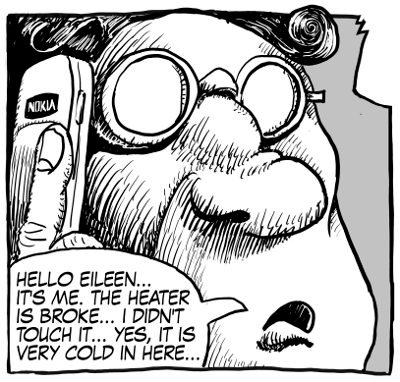
When she arrives she finds nothing wrong with the heater... but is instead busted in the CIA operation that was meant to catch Phill.
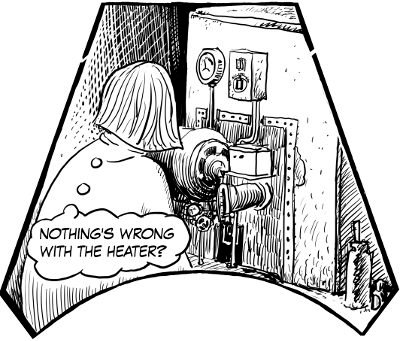
I also use this by paying close attention to my supporting characters - instead of inventing new ones it is much better to reuse an existing on. Not only does it give the reader fewer characters to remember and reusing already existing context, it also develops the character and they even might get much bigger roles than I had originally anticipated. As for Eileen, she already has transcended from a small role as supporting character that was supposed to tell some back story, to a much more prominent position. There is an image in the comic where you see Eileen as fifteen years younger than current, but her name is not mentioned - 2 SBD to the one that finds it first :)Write it in the comments below.
Rule no. 3: Move around
One of the oldest kinds of story is the travelling story. Gilgamesh, Herakles... anybody should be able to continue the list. Using the quest-model is simple and always entertaining. "Then he went there... and then he travelled there... and at last he returned home" Or as J.R.R. Tolkien put it:
The Road goes ever on and on
Down from the door where it began.
Now far ahead the Road has gone,
And I must follow, if I can,
Pursuing it with eager feet,
Until it joins some larger way
Where many paths and errands meet.
And whither then? I cannot say.
Bilbo Baggins leaving the Shire in the Lord of the rings by J.R.R. Tolkien
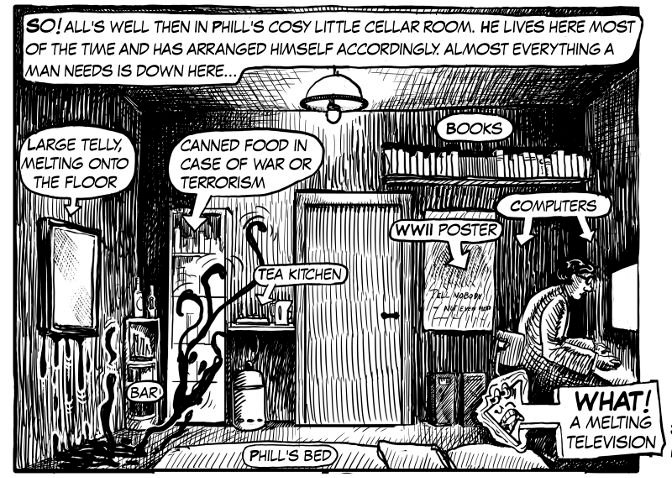
So I have tried to move my hero - from the comfortable, but also lonely life in his cellars (Phill prefers cellars both at home and at the job) to the safe-house in Wales, then the small roundhouse up in the hills where the heathen priestess Gwendolyn and her motley crew of followers live... and now it seems they have to go on a roadtrip to escape CIA, MI6 and other dangerous entities. Contrary to movies where an outside shot i a pain and scenes taking place in other countries are expensive. The comic on the other hand can take place wherever the author likes without any problems - so using this simple principles is an easy way to entertain your audience.
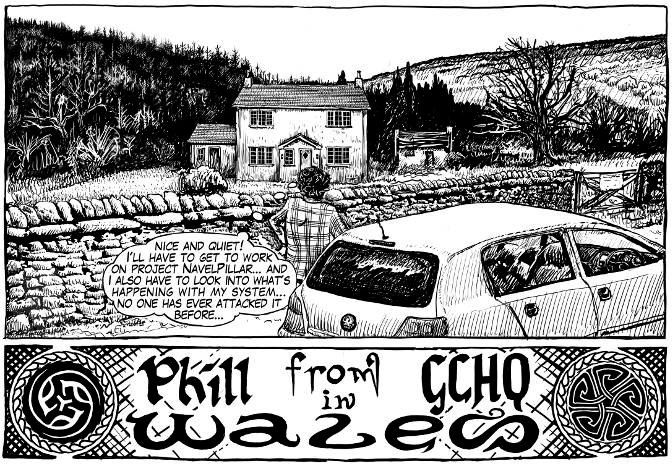
Conclusion... or wait...
Well, is that all? I am not sure? I feel that I have more to say on the topic, but right now it eludes me completely. The post is also far too big to be convenient, but I hope that somebody out there can use it for something. I will try to make some more posts about how I go about creating comics very soon.



Yes, I do.
I also have the complete collection of Thorgal.
Do you know it?
Yes, I do know Thorgal, and I actually saw Rosinski, the Polish artist, in the Copenhagen Comics convention this year when I was out to promote Phill! I didn't get an autograph with Thorgal, though - I'm to shy and the line was too long :)
By the way, I know how to find Eileen 15 years ago, but I am not competing for the 2 SBD.
I will only say that it is between pages 15 and 25.
That is actually not the right answer. I think I know what you mean, but that is not the way it is :)
Oh! Then I must look again.
@shortcut found her - page 30.
Good for him. I looked at page 30, but I did not guess.
I really love your "making of" posts. They provide lots of valuable background information and I always learn something new about the art of comic-making.
Maybe you can have another string to your bow by becoming a professor in a comic university...
I want to make some more... I will soon have to go on a family-holiday, and I will not be able to make pages before August (I do need a little break to plan the next 10 pages). So instead I think I will write something about how I make the comic.
Maybe you can take a guess at where the image of Eileen fifteen years younger is?
Ah, that was tough. I guess it is an ugly old tart on page 30, isn't it?
Summer holidays sound like a real good plan and I'm really looking forward to your how-to's.
Well, that seemed to be not that tough. Correct!
I actually had to flip through all the pages two times to find her ;-)
Great!
Thanks :)
I really like your style. Do you use pen on paper or is this digital? I've been trying to make a comic for so long now. I have all these different story lines but I can never seem to just commit to one and stick with it. Have you ever had this problem?
I do as much of it digitally - it is part of the concept of this pseudonym - but I still make sketches and some of the early page-breakdown with paper and pencil. But with the possibility to erase the ink, I try to simply make the inking part the most important one.
I sure have had problems with all the many ideas I have for stories and universes. But I think that the best advice is simply to pick one and get going. Just think of it as starting from one end. I will gladly give some advice if you decide to begin on something. I am not a comic expert, but I have the experinec from the last 8-9 month making the Phill-comic. If you get something going there might be readers to satisfy too? That is a great incentive. You can see here how Phill from GCHQ began in this old Steemit post.
I like your drawings very much and would love to see it put into some kind of storyline.
Thanks for the advice. I'll let you know if I ever get one up and running.
I hope you do!
Wow you should post this stuff on shirts with merch by amazon. You'd make a lot of sales!
Merch really sounds like a cool idea, but it should to be printed by a more decentralized company (that also accepts cryptos.)
I am not really able to go as mainstream as Amazon, but yes I will consider some merchandise - but maybe I shall concentrate on a bigger following first.
Well, maybe I should get into merchandise :) That's where the money are they say.
Hey fellow comic artist. Greetings from USA. This post was really great. I love the panels that label items and actions. I need to incorporate that in my work. It's something that works great in comics.
A late hallo back. Greetings from Scsandinavia! Glad you can use it for something. It's true that labels work very well in some style. Especially, I think, if you also have a narrator of some kind.
I really enjoy the comic, great work :D
Glad you like it!
I love the style of these - I especially love the odd shapes that contain some of the scenes! Great stuff :)
Thanks! I grew up with the European tradition of comics, so I plunged myself into the long narrative where the larger page gives a higher degree of freedom when it comes to strange page-composition.
Its awesome - I don't know much about European comic tradition - I will have to do more research - if you have some good articles or resources that would give me a high level or even deep level understanding of the tradition or style as a whole, please do. I want to learn more about it!
Very simplified I think you can say that European comics started to differ from the American before WWII. The serials was collected in the 46 page album in A4 paper size, while American comic stayed in newspaper or small magazine sizes. It was the Belgian Tintin and Spirou that was leading in this development and it made the European comic more like a novel while the American kept being serialised short stories.
The comic I am making is on page 35, and I intend to use the summer to plan the last 11 pages so it can make a traditional album - The story does not end there so it will be like the first act or a chapter which was also common later. Some of the Tintin albums was connected - The Secret of the Unicorn and Red Rackham's Treasure for example.
Later comics was considered art in France and that gave rise to some fantastic experiments that really influenced both the American and the Japanese comic scene. But at that time the American underground-comic was also sending influence back. My comic is very inspired by some of the American artists as you will see ... :)
Great article!
This is very useful to me as well, since I want to start writing fantasy soon, especially the first tip, the "Always end the page with a cliffhanger" one. It's really interesting and I can already see how that can be easily implemented in a fantasy story.
Great job with the article, keep up the good work and best of luck!
Thank you! I'm glad you could use some of the things in the post. Looking forward to reading your fantasy - so I followed you.
Thank you very much! :) It's already finished, and I just need to change a few things and add more to the story, but I will post it in the following days!
Great post and very interesting tips, thanks for sharing !
Thanks a lot!
Great write up! Thanks for sharing!! :)
You're more than welcome!
nice
Thank you :)
Great post
Thanks.
Thanks for sharing with us all that amazing info!) You do great job!
Your welcome. Glad you liked it.
I love how you help teach storytelling fundamentals through a short and exciting post with your comic passion. I love you artwork and am a storyteller myself. I am very encouraged and helped by your post.
I glad you can use it!